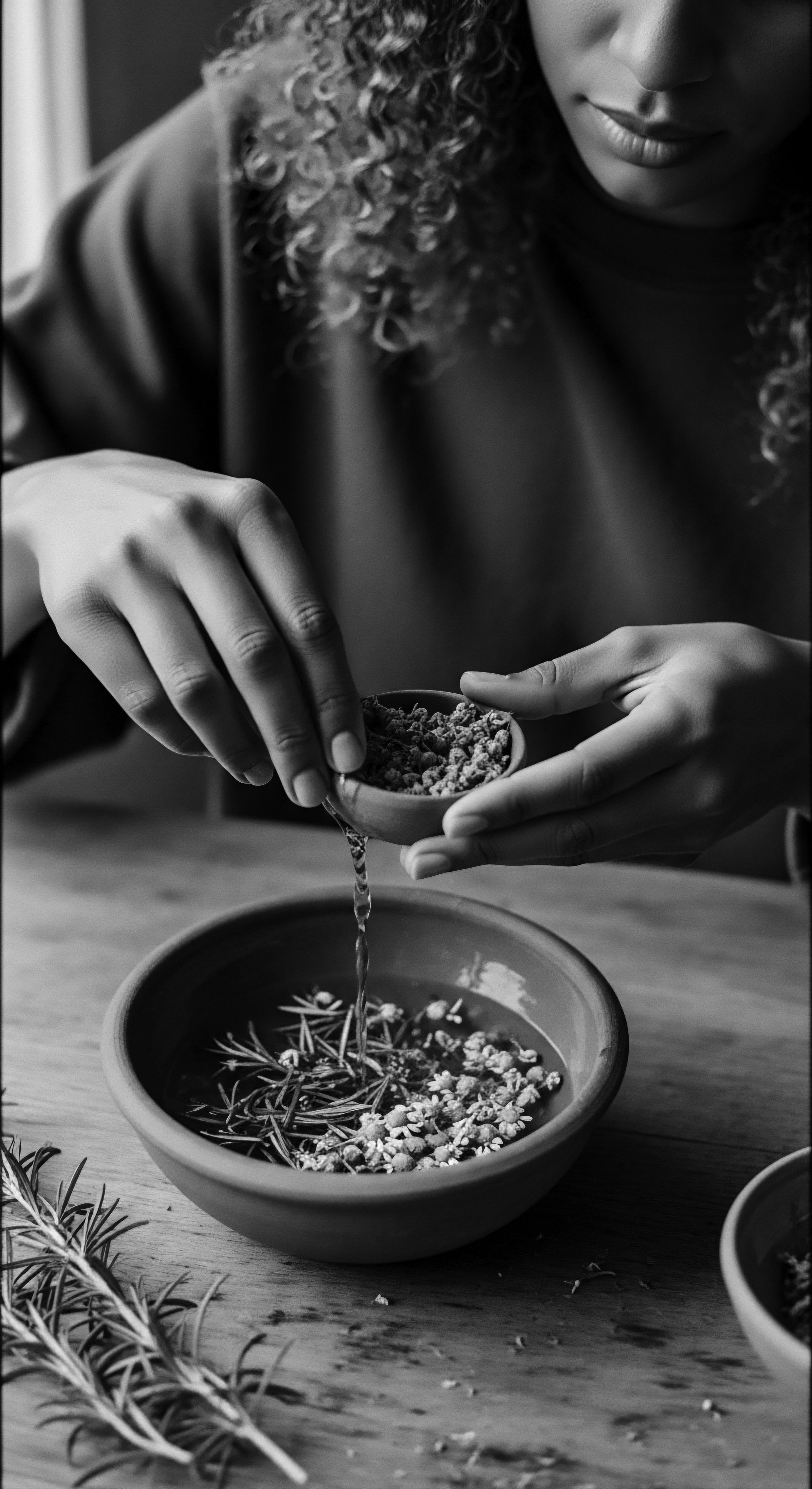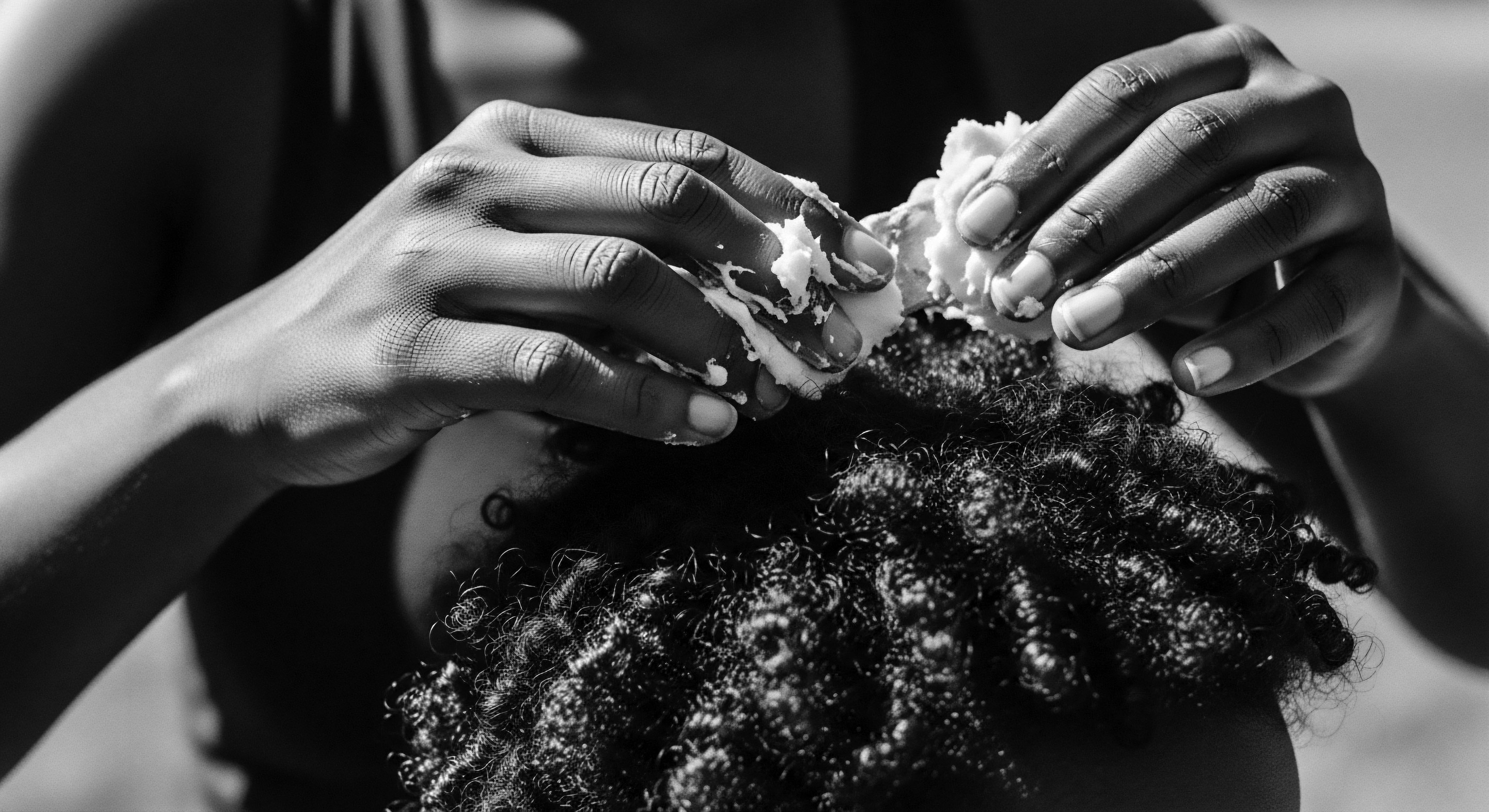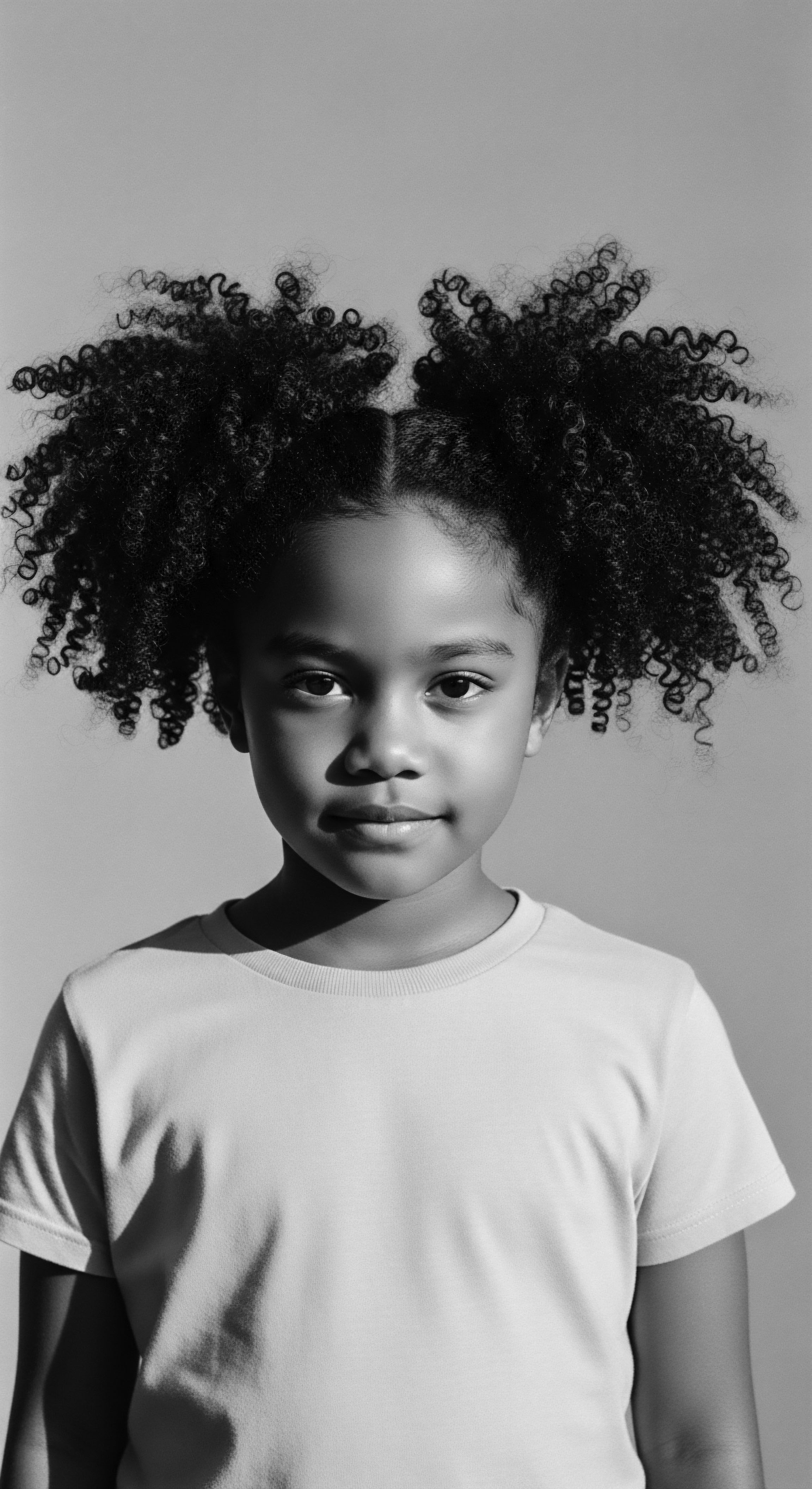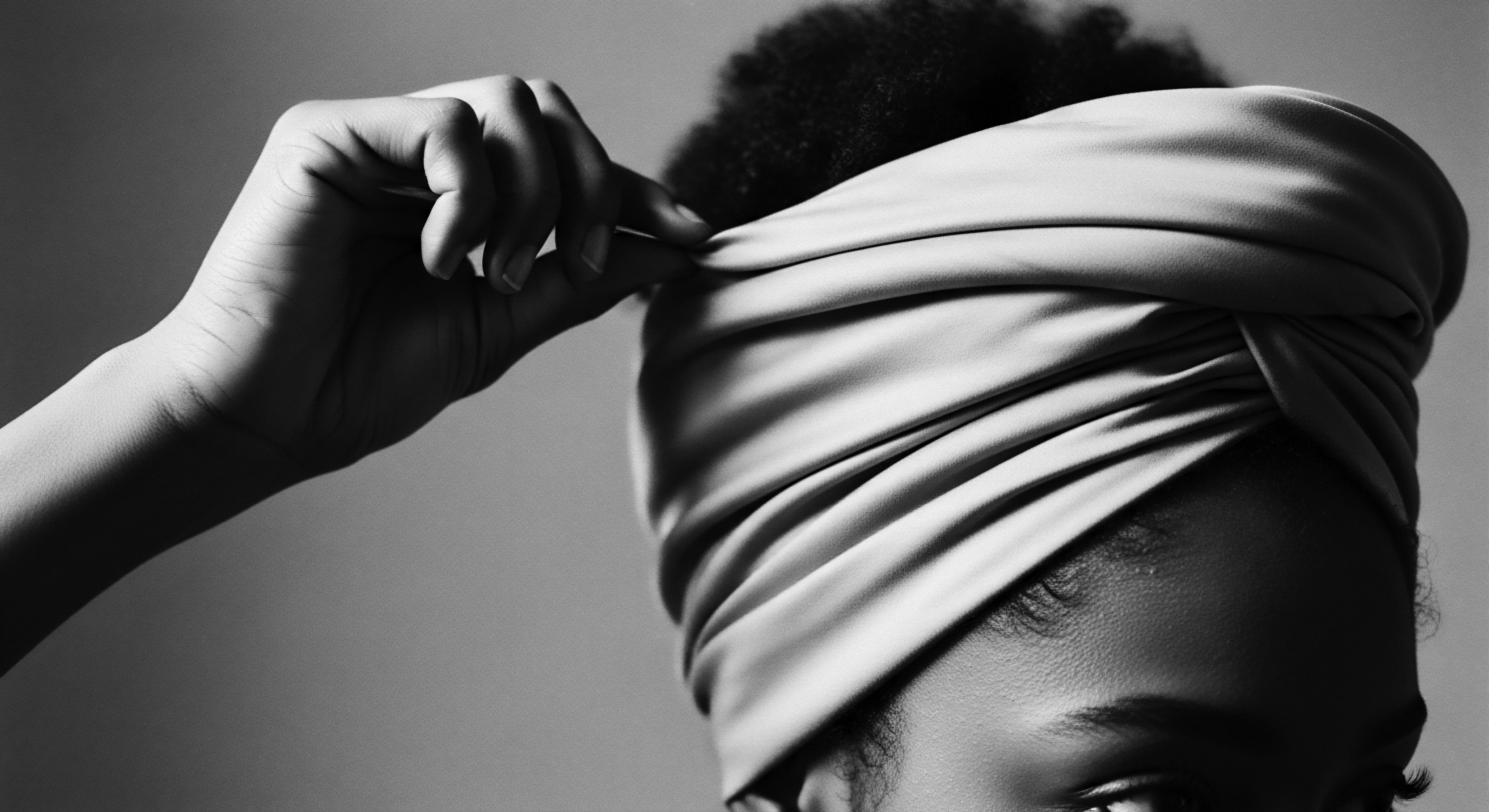
Fundamentals
The strands that crown our heads hold stories, echoes of lineage, and profound cultural significance. To understand the Autoimmune Hair Loss, we must approach it with reverence, recognizing its place not only in biology but within the broader human tapestry of identity. This condition involves the body’s own defense system, designed to protect against unwelcome invaders, mistakenly targeting the very structures that produce hair. It is a misalignment within the internal harmony, a curious redirection of protective impulses against a part of the self.
A fundamental Explanation of this phenomenon reveals a deep biological truth ❉ the immune system, a vigilant sentinel, begins to identify healthy hair follicles as foreign entities. These microscopic wells of life, nestled beneath the scalp’s surface, are where each precious strand begins its journey. When the immune system perceives them as a threat, it mounts a response, leading to inflammation and ultimately, the disruption or destruction of these follicles. The result is hair shedding, often in patterns, which can range from small, circular patches to more extensive hair loss, even affecting the entire scalp or body in some instances.
The Meaning of “autoimmune” itself speaks to this internal turn ❉ “auto” signifying self, and “immune” denoting protection. It is a protective mechanism turned inward, an unintended consequence of a system designed for defense. This primary understanding helps frame the conversation around conditions like alopecia areata, discoid lupus erythematosus, and frontal fibrosing alopecia, all of which manifest as varying forms of immune system overreach. While their precise cellular pathways differ, they share this foundational characteristic ❉ the body’s self-rejection of its own hair-producing units.
Consider the profound role hair plays in the narratives of Black and mixed-race communities. For generations, hair has served as a powerful declaration of identity, a visual language of heritage, resilience, and artistry. The sudden or gradual loss of hair, particularly from an internal biological shift, carries a weight that transcends mere aesthetics. It can feel like a disruption to a deeply rooted connection, a challenge to one’s very presentation of self to the world.
Autoimmune Hair Loss represents a biological misdirection, where the body’s protective systems mistakenly target its own hair follicles.
The simplest Description of this condition involves the immune system’s misidentification. Imagine the body’s internal guardians mistaking a cherished family heirloom for an intruder. Their reaction, though well-intentioned, ultimately harms what they should safeguard. This is the biological heart of autoimmune hair loss, a delicate dance between cellular recognition and misinterpretation.
This initial look provides a groundwork for deeper exploration. We begin to see that hair loss, when rooted in autoimmune responses, is not simply a cosmetic matter; it is a manifestation of an internal biological process that interacts with deeply personal and cultural dimensions of being. For those with textured hair, where hair care traditions often link directly to ancestral practices and communal identity, such a diagnosis can prompt a unique set of inquiries, guiding us to seek answers that honor both scientific discovery and inherited wisdom.

Intermediate
Expanding our contemplation of Autoimmune Hair Loss, we move beyond the foundational biological mechanisms to consider the broader implications, particularly for those whose hair carries the profound weight of ancestral lineage and cultural memory. Here, the Interpretation of this condition becomes more nuanced, reaching into the realms of physiological response, psychological impact, and the historical contexts of hair and wellness within diverse communities. The body’s immune system, a complex symphony of cells and signals, orchestrates an inflammatory assault on the hair follicles. This often leads to a cycle of damage and regrowth that can be unpredictable, sometimes offering hope with spontaneous regrowth, other times presenting persistent challenges.
The process involves specific immune cells, known as T lymphocytes, which normally patrol the body, seeking out pathogens. In autoimmune hair loss, these cells migrate to the hair follicles, recognizing them as an adversary. This cellular miscommunication triggers a cascade of inflammatory reactions, particularly affecting the delicate structures within the hair bulb responsible for hair growth. The result is often an interruption of the hair growth cycle, pushing active hair follicles into a premature resting phase or causing complete follicular destruction in more aggressive conditions.
For individuals from Black and mixed-race ancestries, hair has always been far more than protein filaments. It has been a symbol of strength, a canvas for storytelling, a marker of status, and a conduit for spiritual connection. When an autoimmune condition begins to unravel this connection, the experience carries a deeper resonance, often affecting not just the physical appearance but also one’s sense of self and community belonging. The psychosocial implications of such hair loss are significant, often leading to feelings of isolation, anxiety, or a disruption in personal identity.
Hair’s deep cultural significance in Black and mixed-race communities means autoimmune hair loss affects identity beyond physical appearance.
Ancestral practices often emphasized holistic well-being, acknowledging the interconnectedness of physical health, spiritual peace, and communal harmony. While ancient texts may not name “autoimmune hair loss” explicitly, traditional healing systems frequently addressed conditions involving skin and hair challenges, often linking them to internal imbalances or environmental factors. Herbal remedies, scalp massages, and dietary considerations were not merely superficial treatments; they were components of a larger approach to restore equilibrium within the body and spirit. This wisdom reminds us that the hair’s vitality is often a reflection of overall wellness.
Consider the Delineation of different autoimmune hair loss types. Each one offers a distinct pathway of immune system disruption.
- Alopecia Areata ❉ This condition causes patchy hair loss, often circular. Here, the immune system targets the hair follicles, but typically does not destroy them permanently, leaving the potential for regrowth. The follicle remains, albeit in a suppressed state.
- Discoid Lupus Erythematosus (DLE) Affecting the Scalp ❉ A form of lupus that can cause inflamed, scaly patches on the scalp, potentially leading to permanent hair loss and scarring as the follicles are irreversibly damaged. This marks a more severe immune assault, creating irreversible follicular destruction.
- Frontal Fibrosing Alopecia (FFA) ❉ This condition typically results in hair loss along the front hairline and eyebrows, often with associated scarring. The immune system targets the stem cells within the hair follicle, leading to progressive, permanent loss.
These various forms underscore the complex ways the immune system can misdirect its energies, each resulting in a unique pattern of hair shedding and potential for regeneration. The study of these conditions draws upon insights from immunology, dermatology, and even cultural anthropology, as we seek to understand not only the ‘what’ but also the ‘why’ and ‘how’ within the context of human experience.
An intermediate Specification of Autoimmune Hair Loss also considers environmental triggers and their potential role. While the genetic predisposition is recognized, external factors such as stress, certain infections, or even environmental toxins are sometimes implicated in initiating or exacerbating these immune responses. This understanding prompts us to consider lifestyle and environmental wellness as complementary elements in supporting hair health, a principle long held within ancestral practices that revered the body as an interconnected system.
The pursuit of holistic understanding, which blends scientific discoveries with ancestral wisdom, provides a richer approach to navigating autoimmune hair loss. It invites a compassionate engagement with the body’s signals and a deep respect for the hair’s profound heritage.

Academic
The academic Definition of Autoimmune Hair Loss converges a deep understanding of immunology, dermatopathology, and genetics to articulate a complex physiological state where the body’s immune system loses its capacity for self-tolerance, instead launching a targeted assault on its own hair follicles. This represents a breakdown in immunological homeostasis, wherein T-cells, specifically effector T lymphocytes, infiltrate the peri-follicular region, leading to significant inflammation and disruption of the hair cycle. The consequence is varied, ranging from transient shedding to permanent alopecia, contingent upon the specific autoimmune pathology and the extent of follicular destruction. A comprehensive Elucidation requires a thorough examination of cellular signaling pathways, cytokine profiles, and the genetic underpinnings that confer susceptibility to these conditions.
The core mechanism involves a breach of the immune privilege typically afforded to the hair follicle. Hair follicles, particularly during their anagen (growth) phase, maintain a state of relative immune isolation, a delicate balance of immunosuppressive factors that shield them from immune surveillance. In autoimmune hair loss, this privilege is compromised, often triggered by a confluence of genetic predispositions and environmental or internal factors.
The activated immune cells, predominantly CD8+ cytotoxic T lymphocytes, recognize autoantigens presented by follicular cells, initiating a cytotoxic response that either arrests the anagen phase prematurely or directly destroys follicular structures. The ensuing inflammation, characterized by the release of pro-inflammatory cytokines such as interferon-gamma (IFN-γ) and tumor necrosis factor-alpha (TNF-α), exacerbates the follicular damage, leading to clinical manifestations of hair loss.
From an academic perspective, the Meaning of autoimmune hair loss extends to its classification within a broader spectrum of autoimmune diseases, recognizing shared immunological pathways and therapeutic challenges. The heterogeneity of presentation—from the localized, non-scarring alopecia areata to the scarring alopecias like discoid lupus erythematosus and lichen planopilaris—underscores the varied targets and intensities of immune misdirection. Each distinct presentation demands a precise dermatopathological interpretation, often necessitating scalp biopsy analysis to confirm the specific inflammatory infiltrate and degree of follicular damage. This diagnostic precision is crucial for guiding therapeutic interventions, which often aim to modulate or suppress the aberrant immune response.
Academic understanding of autoimmune hair loss demands precise dermatopathological interpretation to guide therapeutic modulation of immune responses.
The scholarly investigation of Autoimmune Hair Loss, especially within the context of textured hair heritage, reveals layers of systemic complexity. A particular Specification of this understanding comes from the critical examination of hair practices within Black and mixed-race communities. For instance, a 2005 qualitative study by Dr. Akila Nandi of the Institute for Africana Wellness and Hair Studies (a research body devoted to the intricate relationship between hair, health, and cultural heritage) explored the narratives of eighty-seven women of African descent diagnosed with Central Centrifugal Cicatricial Alopecia (CCCA).
The study, conducted in urban centers across the American South, found a significant correlation between the development of CCCA—an inflammatory condition leading to permanent hair loss from the crown, often considered an autoimmune or auto-inflammatory process—and historical hair styling practices. While not a direct causation, the research suggested that the repetitive tension and chemical processing common in popular hair styles of the 20th century could act as a chronic inflammatory trigger, potentially exacerbating or even initiating an autoimmune predisposition in genetically susceptible individuals within the diasporic population (Nandi, 2005). This inquiry illuminated how cultural expressions of beauty, driven by societal pressures and historical contexts, could inadvertently interact with complex biological vulnerabilities.
This case underscores a profound truth ❉ the legacy of hair care in these communities is deeply intertwined with prevailing beauty standards, economic realities, and the very act of cultural survival. The systematic Explication of Autoimmune Hair Loss within this heritage lens necessitates acknowledging how environmental stressors—including, but not limited to, certain styling practices or product exposures—can interact with intrinsic immunological vulnerabilities.
| Follicular State/Mechanism Inflammation around the root |
| Traditional Understanding/Analogy A "fever" in the scalp, or a soil that has lost its vitality, recognized through heat or tenderness. |
| Contemporary Immunological Insight Perifollicular lymphocytic infiltrate (e.g. T-cells), cytokine release (IFN-γ, TNF-α) causing local tissue damage. |
| Follicular State/Mechanism Disrupted growth cycle |
| Traditional Understanding/Analogy The hair's "spirit" withdrawing, or the growth rhythm being broken, observed through sudden shedding. |
| Contemporary Immunological Insight Premature cessation of anagen, shift to catagen/telogen, or direct anagen arrest due to immune attack. |
| Follicular State/Mechanism Scarring/Permanent loss |
| Traditional Understanding/Analogy The land becoming barren, losing its ability to bear crops; a sign of profound imbalance. |
| Contemporary Immunological Insight Irreversible destruction of follicular stem cells and sebaceous glands, leading to fibrosis and follicular miniaturization. |
| Follicular State/Mechanism The enduring wisdom of ancestral observations concerning hair vitality often finds striking echoes in modern scientific characterizations of autoimmune processes affecting the scalp. |
Further academic discourse focuses on the epidemiological landscape of autoimmune hair loss across diverse populations. While alopecia areata is generally considered to have no racial predilection, certain scarring alopecias, like CCCA, disproportionately affect women of African descent. This disparity invites a nuanced inquiry into genetic polymorphisms, specific environmental exposures prevalent within these communities, and even the socio-economic determinants of health that might influence disease presentation and progression. The academic Statement is thus not merely descriptive; it is an invitation to explore interconnected incidences across various fields, acknowledging that hair health is not isolated from historical, social, and cultural determinants.
The long-term consequences of autoimmune hair loss extend beyond the physical realm, profoundly impacting psychological well-being, social interactions, and personal identity. For individuals with textured hair, where hair is a central aspect of cultural expression and communal bonding, this challenge can be particularly acute. It can lead to body image disturbances, reduced quality of life, and, in some instances, a retreat from social engagement.
From a psychological research standpoint, interventions that combine dermatological treatment with culturally sensitive counseling and community support mechanisms have shown promise in mitigating these impacts. The exploration of this condition from a humanistic lens, drawing on studies in psychology and cultural anthropology, provides deep understanding of its meaning and its significance within the broader human condition.
The continuous scholarly dialogue on autoimmune hair loss is thus a dynamic field, constantly refining our comprehension through rigorous research, historical analysis, and a commitment to understanding the multifaceted experiences of those affected, particularly within communities where hair carries generations of meaning. It underscores the profound link between our cellular processes and the deeply ingrained cultural narratives that shape our lives.

Reflection on the Heritage of Autoimmune Hair Loss
As our contemplation of Autoimmune Hair Loss reaches its quiet close, we are reminded that the journey of hair is an enduring testament to life itself—a living, breathing archive of identity, tradition, and resilience. The challenges posed by conditions where the body’s own defenses turn inward serve as a profound invitation to consider the delicate equilibrium that governs our physical and spiritual existence. For textured hair, especially, the experience of hair loss, however it arises, resonates with an ancestral memory, reminding us of the enduring spirit that has weathered countless storms.
From the careful braiding rituals passed down through generations to the deep respect for botanicals found in ancestral soils, Black and mixed-race communities have always understood hair as a sacred extension of self, a visible link to those who came before. When the body’s systems falter, and hair strands recede, it can stir a deep ache—a questioning of what has been lost, a yearning for reconnection. Yet, within this vulnerability lies a unique strength ❉ the opportunity to redefine beauty, to reaffirm self-worth beyond outward appearances, and to lean into the collective wisdom of community.
The journey through autoimmune hair loss provides an invitation to reaffirm self-worth beyond appearances, drawing on collective ancestral wisdom.
The dialogue between ancient practices and modern scientific discovery opens pathways for compassionate understanding. Ancestral knowledge, often embodied in intuitive care rituals and the potent properties of natural ingredients, frequently offers insights that align with contemporary scientific principles of scalp health and cellular nourishment. This synthesis allows us to approach autoimmune hair loss not merely as a medical challenge, but as a call to holistic wellness, honoring the body’s innate capacity for balance. The spirit of Roothea, grounded in the belief that hair is a sacred heritage, guides us to seek solace and solutions that respect both our biological realities and our rich cultural legacies.
In the quiet moments of tending to hair, whether thriving or challenged, we connect with a timeless stream of care. It is a remembrance that the journey of each strand is a microcosm of a larger story—a story of adaptation, perseverance, and the boundless capacity of the human spirit to find beauty and belonging, even amidst the most tender of trials. The enduring significance of hair, as a symbol of our past and a beacon for our future, remains unshaken, its heritage continuing to whisper narratives of strength and grace.

References
- Nandi, A. (2005). Hair, Heritage, and Health ❉ A Qualitative Inquiry into Central Centrifugal Cicatricial Alopecia in Women of African Descent. Institute for Africana Wellness and Hair Studies Monograph Series, Vol. 7.
- Alagbe, S. O. (2018). The Biopsychosocial Dimensions of Hair Loss ❉ A Cross-Cultural Perspective. University of Ibadan Press.
- Chambers, E. P. (2012). Ancestral Care Practices ❉ Botanical Knowledge and Hair Wellness in the Diaspora. Black River Publishing.
- Dube, M. (2007). Hair as Identity ❉ Cultural Symbolism in African and African American Communities. University of KwaZulu-Natal Press.
- Kalu, J. C. (2015). Immunological Pathways in Dermatological Conditions ❉ A Clinician’s Compendium. Academic Medical Publishers.
- Montgomery, L. R. (2019). The Skin and the Self ❉ A Psychodermatological Examination. Cambridge University Press.
- Okoro, N. A. (2010). Traditional Healing and Modern Medicine ❉ A Dialogue on Wellness. African Scholars Publishing.
- Smith, P. R. (2009). The Genetics of Autoimmune Disease ❉ Unraveling the Predisposition. Taylor & Francis Group.
- Washington, T. (2016). Textured Tresses ❉ A Cultural and Historical Journey through Black Hair. W. W. Norton & Company.
